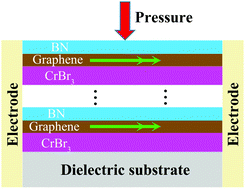Possible realization of the high-temperature and multichannel quantum anomalous Hall effect in graphene/CrBr3 heterostructures under pressure†
Abstract
The recent studies of magno-assisted tunnelling in ferromagnetic van der Waals heterostructures formed by graphene and ultrathin CrBr3 films (D. Ghazaryan et al., Nat. Electron., 2018, 1, 344) offer broader opportunities for exploration of novel quantum phenomena, especially for realizing the graphene-based quantum anomalous Hall effect (QAHE). Based on first-principles approaches, we reveal that three types of graphene/CrBr3 (Gr/CrBr3) heterostructures exhibit metallic band behavior due to strong charge-transfer at the interfaces of these heterosystems. Remarkably, the pressure-induced QAHE can be achieved in Gr/CrBr3 and CrBr3/Gr/CrBr3 systems. Further low energy k·p model analyses show that the nontrivial topological properties are mainly attributed to the Rashba spin–orbit coupling (SOC), but not to the intrinsic SOC of graphene. Moreover, a multichannel device prototype is proposed in the superlattices composed of Gr/CrBr3 and normal insulator (such as hexagonal boron nitride) layers. Our work provides an experimentally feasible scheme for realizing the high-temperature and multichannel QAHE in graphene-based heterostructures.



 Please wait while we load your content...
Please wait while we load your content...